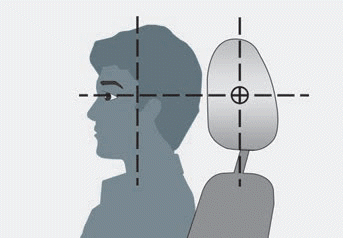Hyundai Venue: Rear Cross-Traffic Collision Warning (RCCW) / System Setting and Operation
System setting
- The driver can activate the system by placing the ignition switch to the ON position and by selecting “User Settings → Driver Assistance → Parking Safety → Rear Cross-Traffic Safety”. RCCW turns on when ‘Rear Cross- Traffic safety’ is selected.
- When the engine is turned off then on again, the system will be activated.
- When the system is initially turned on and when the engine is turned off then on again, the warning light will illuminate for 3 seconds on the outside rearview mirror.

• Setting Warning Timing
The driver can select the initial warning activation time in the User Settings in the LCD display by selecting ‘User Settings → Driver Assistance → Warning Timing’.
The options for initial Rear Cross-Traffic Collision Warning includes the following:
-- Normal:
When this condition is selected, initial Rear Cross-Traffic Collision Warning is activated normally. If this setting feels sensitive, change the option to ‘Late’.
The warning activation time may feel late if a vehicle at the side or rear abruptly accelerates.
-- Late:
Select this warning activation time when driving at a low speed or when Normal feels too sensitive.
Information
If you change the warning timing, the warning time of other systems may change. Always be aware before changing the warning timing.
The driver can select the warning volume of Rear Cross-Traffic Collision Warning by selecting ‘User Settings → Driver Assistance → Warning Volume → High/ Medium/Low’.
Information
If you change the warning volume, the warning volume of other systems may change. Always be aware before changing the warning volume.
Operating conditions
To operate:
Go to the “User Settings → Driver assistance → Parking Safety → Rear Cross-Traffic Safety”. on the LCD display. The system will turn on and standby to activate.
The system will activate when vehicle speed is below 7 MPH (10 km/h) and with the shift lever in R (Reverse).
ÃÃ The system will not activate when the vehicle speed exceeds 7 MPH (10 km/h). The system will activate again when the speed is below 5 MPH (8 km/h).
The system’s detecting range is approximately 1 ~ 65 ft (0.5 ~ 20 m). An approaching vehicle will be detected if their vehicle speed is within 5 ~ 22.5 MPH (8 ~ 36 km/h).
Note that the detecting range and operating speed may vary under certain conditions. As always, use caution and pay close attention to your surroundings when backing up your vehicle.
 System Description
System Description
Rear Cross-Traffic Collision Warning system
Rear Cross-Traffic Collision Warning system uses radar sensors to monitor the
approaching cross traffic from the left and right side of the vehicle when your
vehicle is in reverse...
 Warning and system control
Warning and system control
Rear Cross-Traffic Collision Warning system
Left
Right
If the vehicle detected by the sensors approaches from the rear left/right side
of your vehicle, the warning chime will sound, the warning light on the outside
rearview mirror will blink and a message will appear on the LCD display...
Categories
- Manuals Home
- 1st Generation Venue Owners Manual
- 1st Generation Venue Service Manual
- Automatic Door Lock and Unlock Features
- Remote start
- Theft-Alarm System
- New on site
- Most important about car
Head Restraints
The vehicle’s front and rear seats have adjustable head restraints. The head restraints provide comfort for passengers, but more importantly they are designed to help protect passengers from whiplash and other neck and spinal injuries during an accident, especially in a rear impact collision.
WARNING
To reduce the risk of serious injury or death in an accident, take the following precautions when adjusting your head restraints:
Always properly adjust the head restraints for all passengers BEFORE starting the vehicle. NEVER let anyone ride in a seat with the head restraints removed or reversed.
